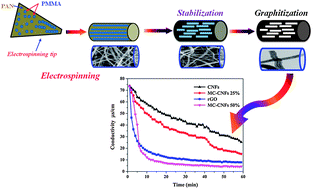Among the various carbonaceous materials, carbon nanofibers (CNFs) are widely utilized in different applications because of their superior mechanical and physicochemical characteristics. However, due to the low surface area compared to other nanocarbonaceous materials, CNFs performance as an electrode in capacitive deionization (CDI) units is comparatively low. In this study, this problem has been overcome by preparing multi-channel carbon nanofibers having a total surface area 10 times more than the conventional CNFs, by creating numerous channels on the nanofibers surface. The modified CNFs have been synthesized using a low cost, high yielding and facile method; an electrospinning technique. Typically, the stabilization and graphitization of electrospun nanofiber mats composed of polyacrylonitrile (PAN) and poly(methyl methacrylate) (PMMA) leads to the formation of multi-channel CNFs due to the difference in the physicochemical characteristics of the two polymers and the complete thermal decomposition of the PMMA during the graphitization step. Three formulations were prepared; 0, 25 and 50 wt% PMMA with respect to the PAN. To properly evaluate the introduced modified CNFs, graphene was prepared using the chemical route. The utilized characterizations indicated that the CNFs obtained from the electrospun solution having 50% PMMA possess a surface area of 181 m2 g−1, which is more than all the investigated formulations including graphene. Accordingly, these nanofibers revealed a salt removal efficiency of ∼90% and a specific capacitance of 237 F g−1. Overall, the present study introduces an effective and simple strategy to distinctly improve the surface area of CNFs, which can strongly enhance their application in CDI technology.

You have access to this article
 Please wait while we load your content...
Something went wrong. Try again?
Please wait while we load your content...
Something went wrong. Try again?


 Please wait while we load your content...
Please wait while we load your content...